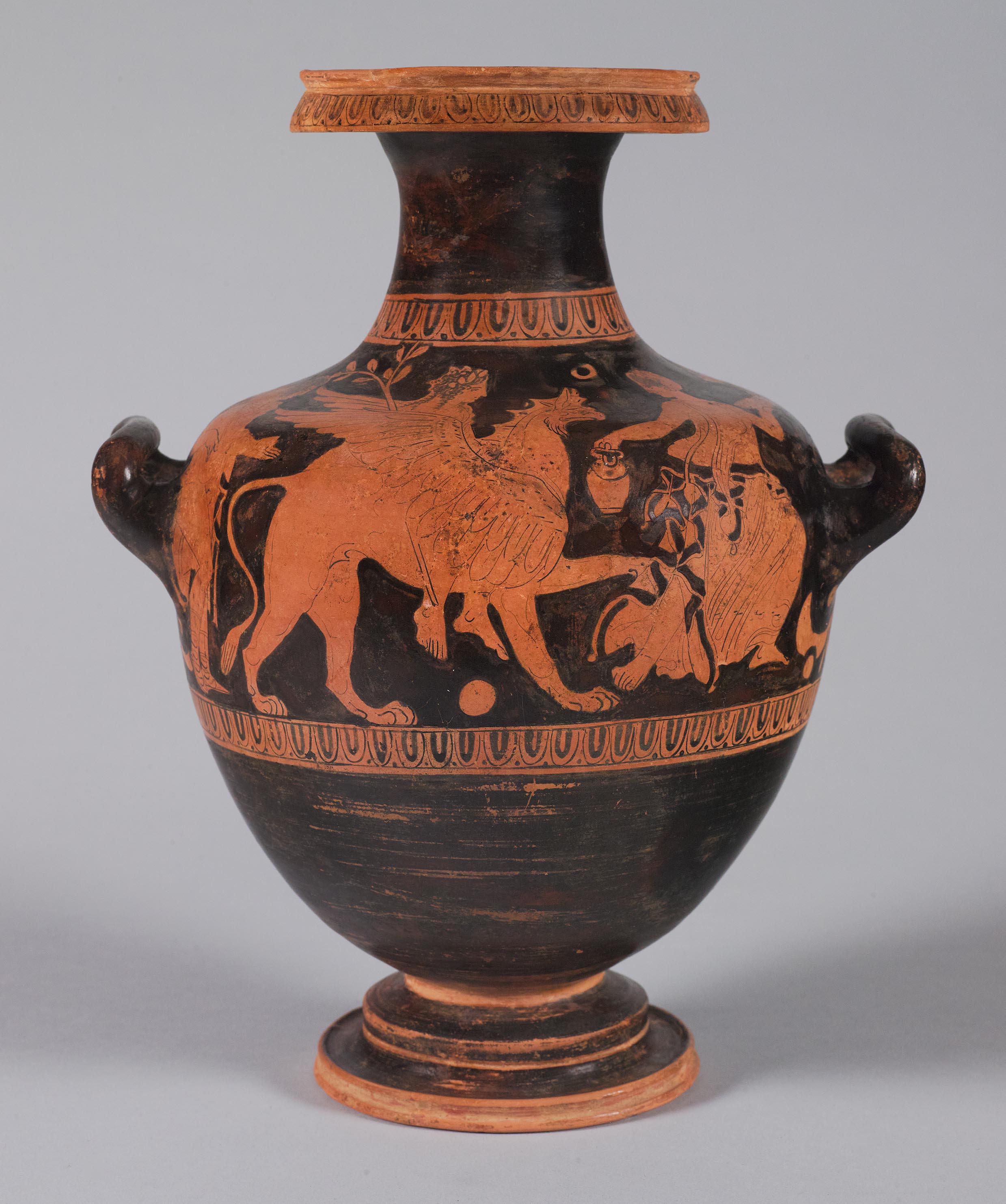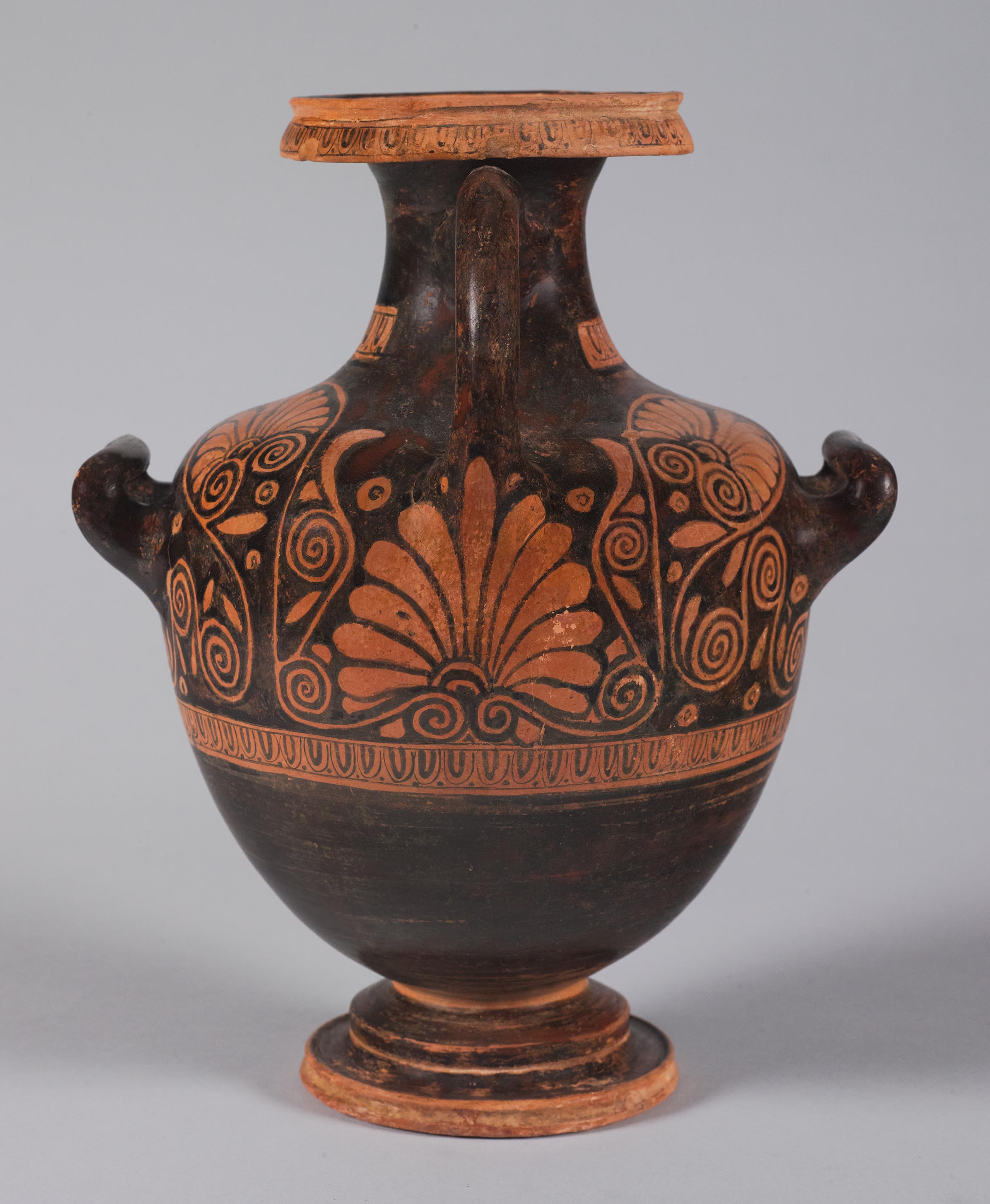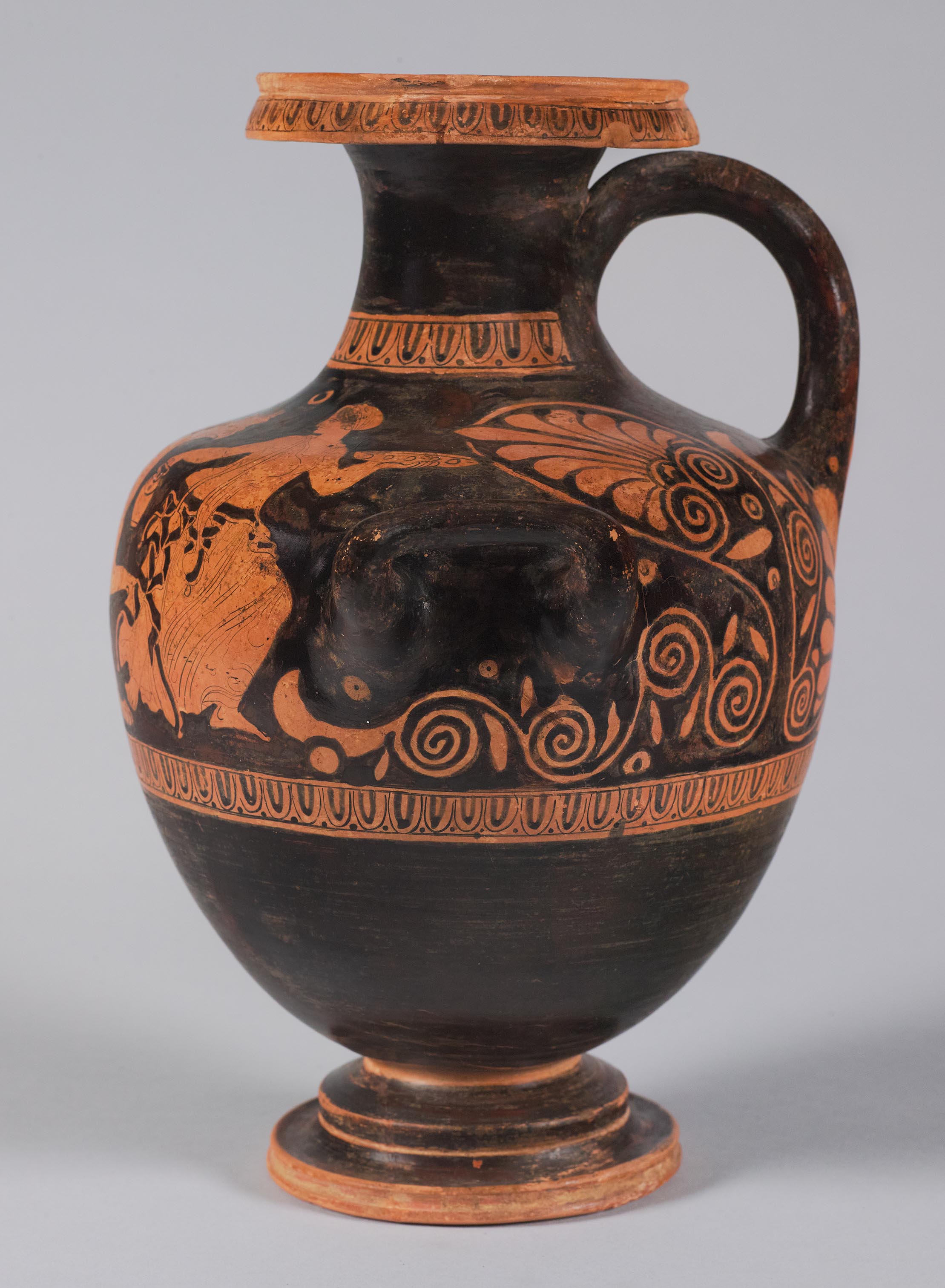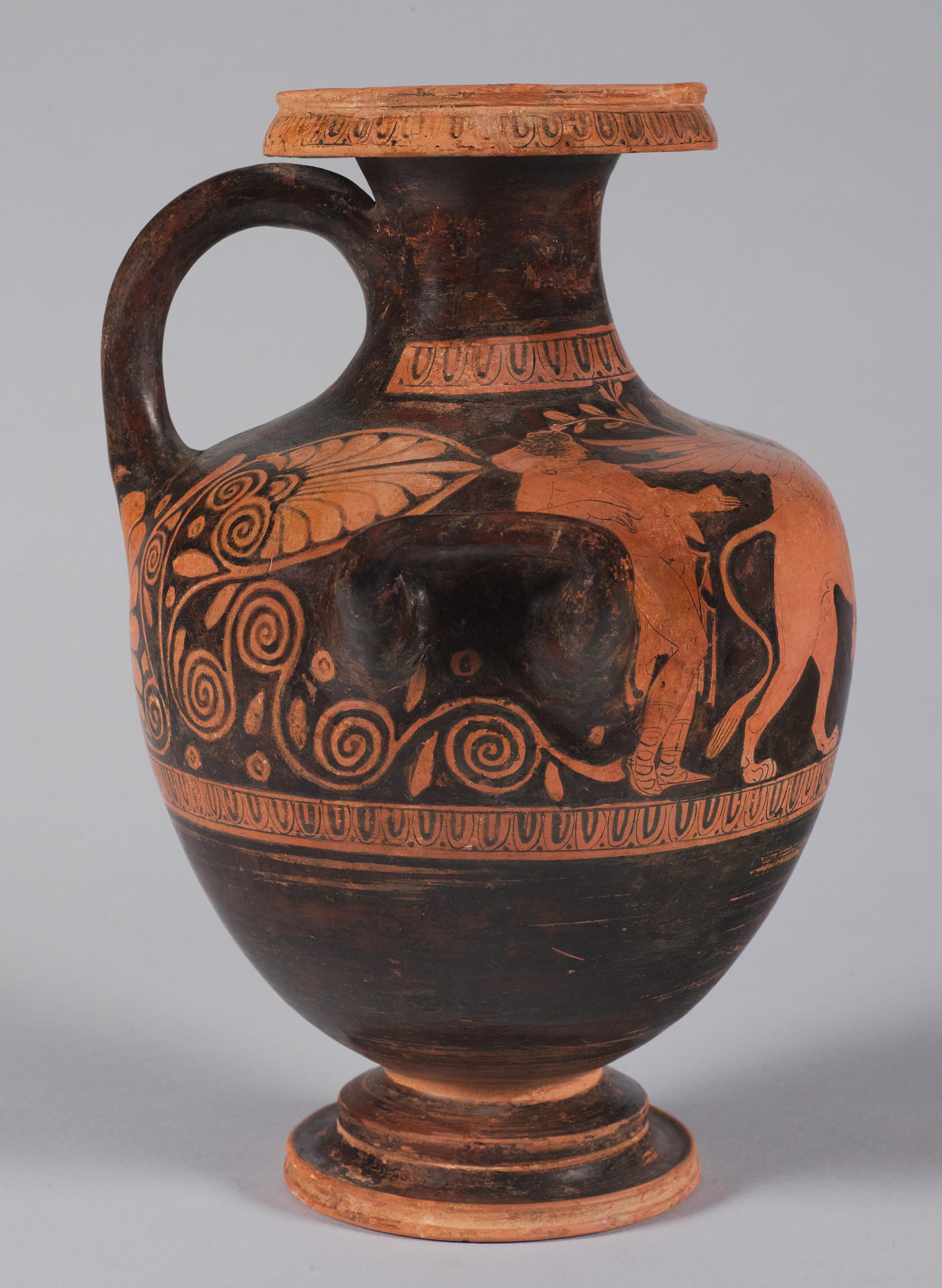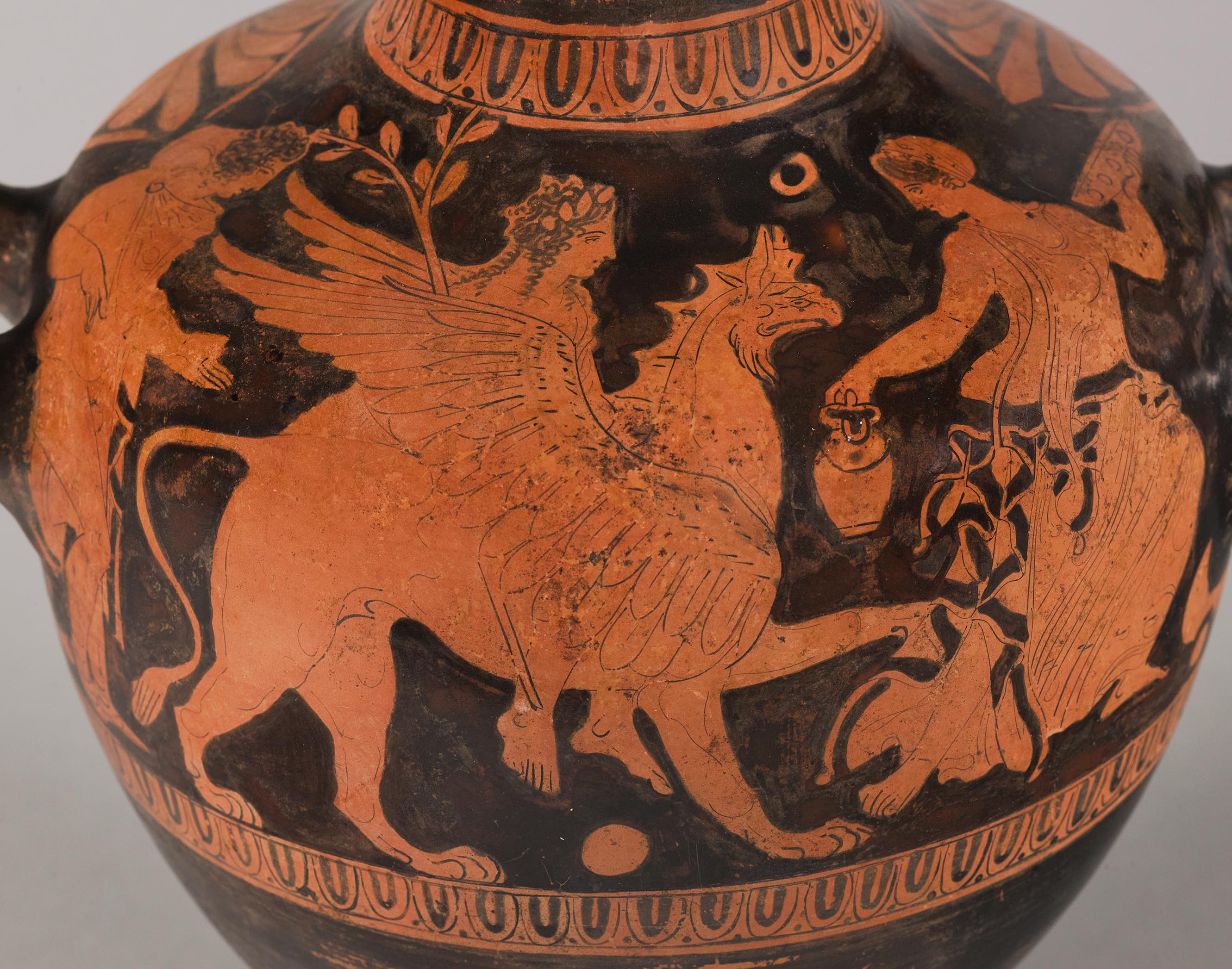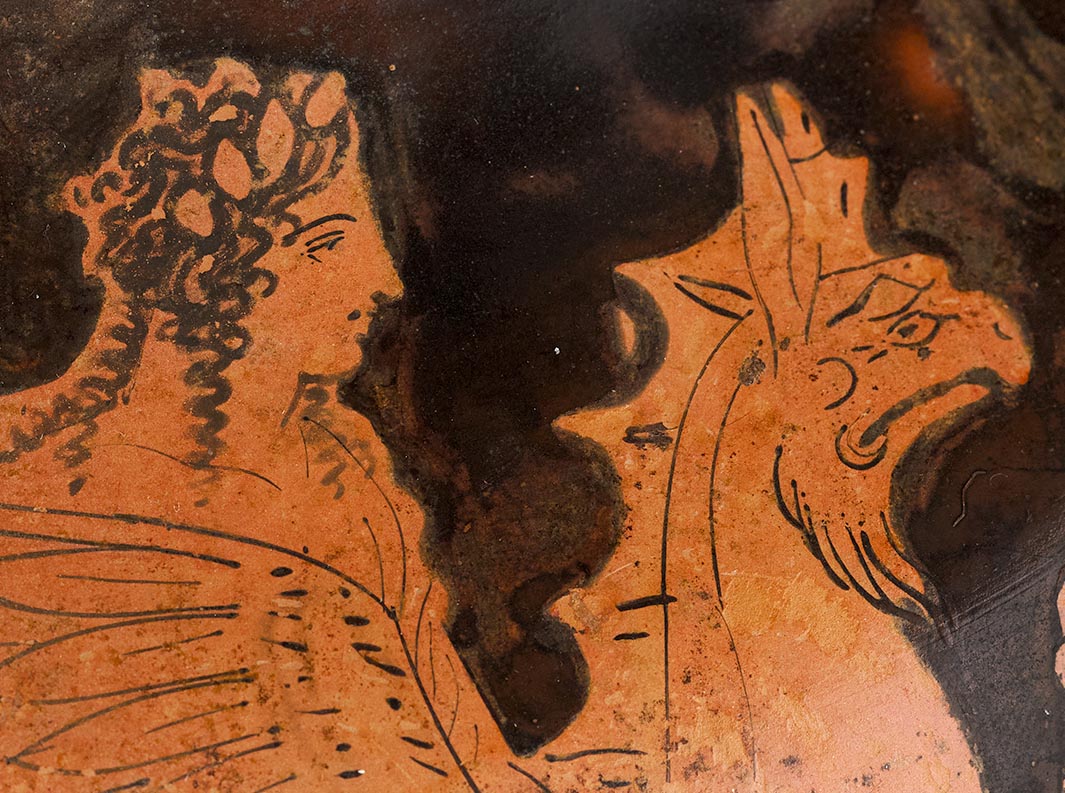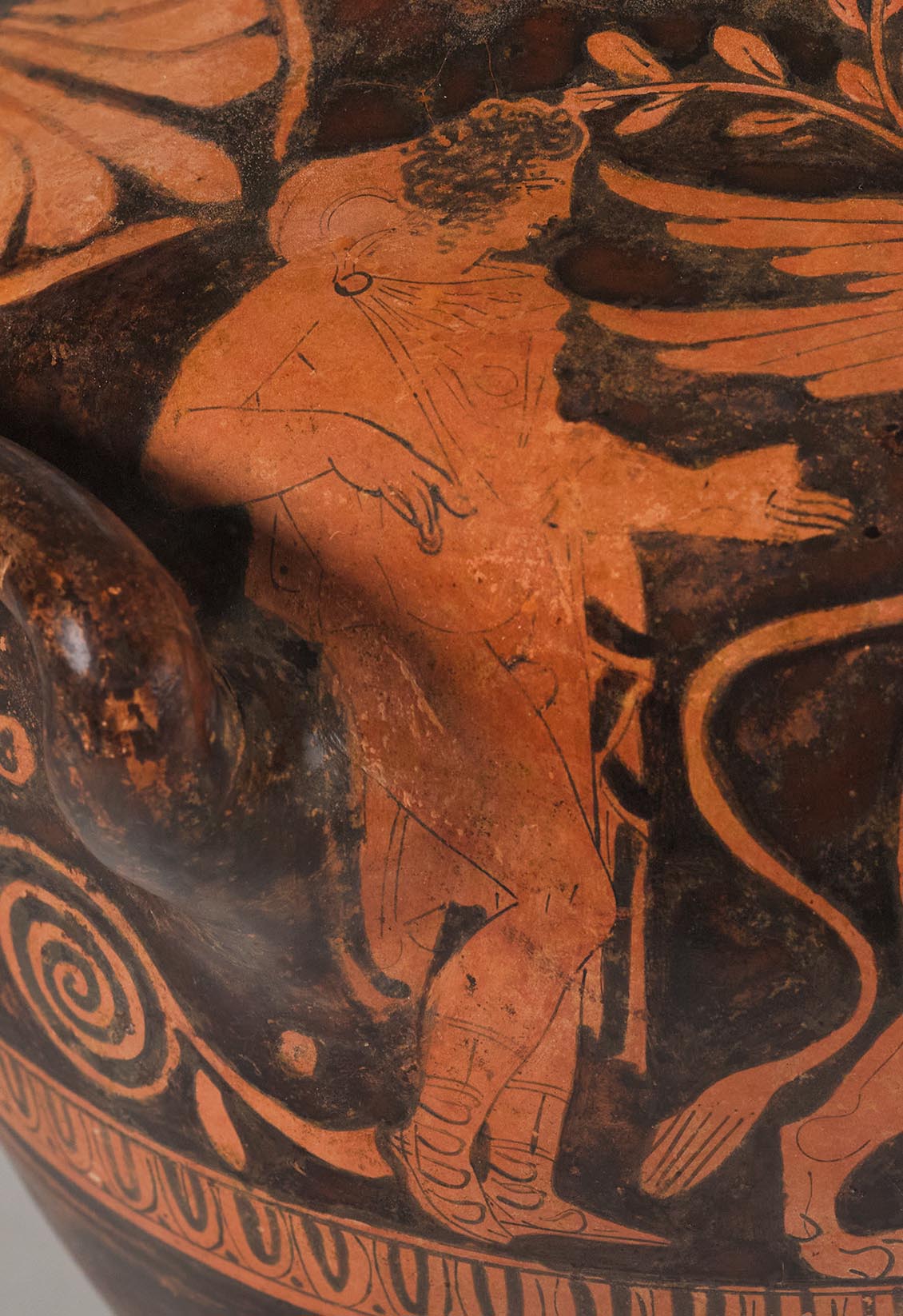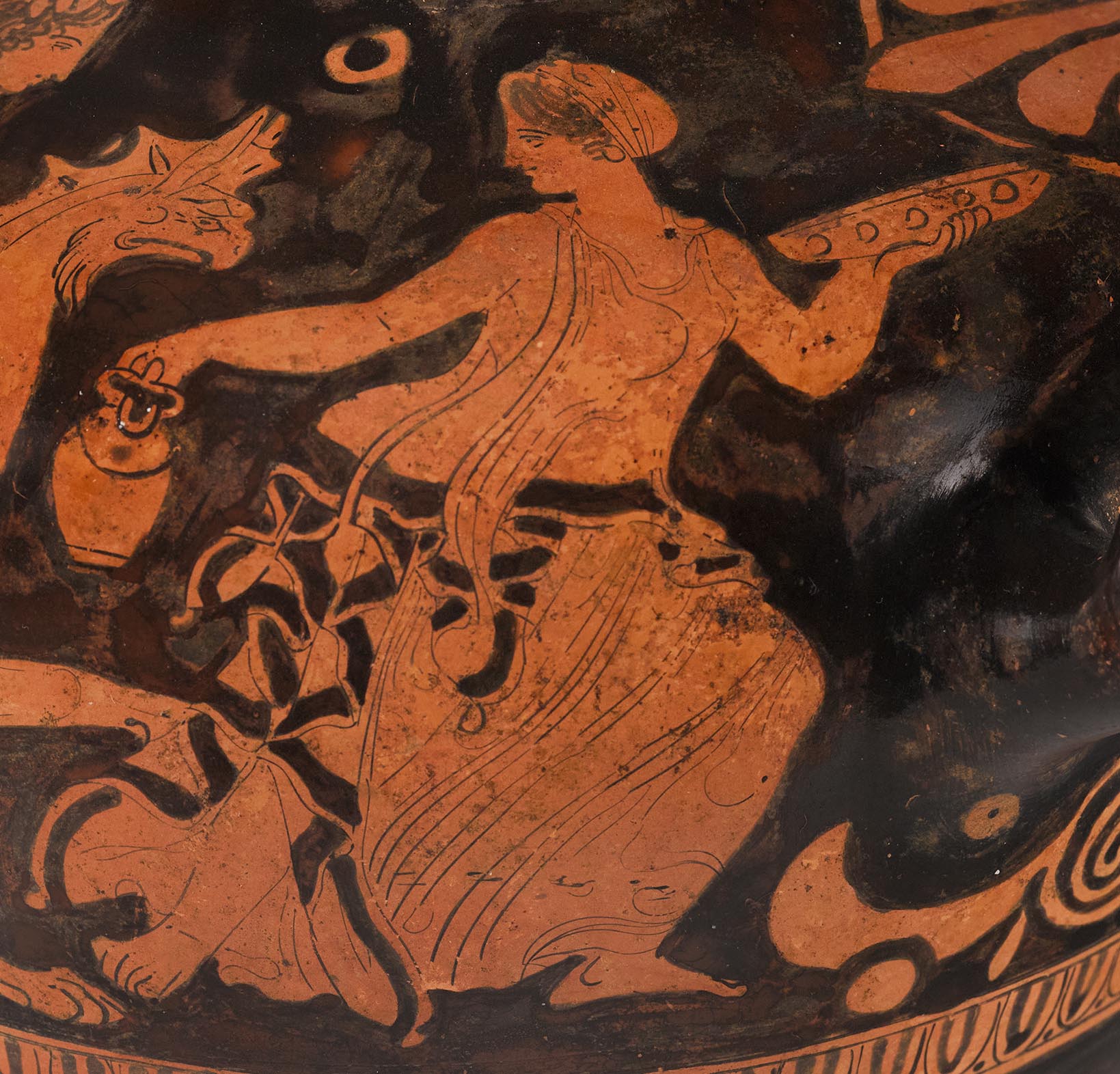Provenance
2003, sale, Charles Ede (London) to Princeton University.
Shape and Ornament
Overhanging rim molded in two degrees; reserved groove between slender reserved lip and painted ovolo molding below. Top of the rim reserved. Interior of mouth and neck black. Band of ovolo framed by two reserved stripes along base of neck, stopping at vertical handle. Continuous profile from neck to foot. Two horizontal handles, round in section, black, on either side of the upper body, curving upward and inward. Black vertical strap handle on back, extending from shoulder to neck. Large palmette with twelve fronds beneath strap handle, framed by coiling tendrils. The latter extend upward on either side to enclose a smaller palmette before splitting into double coils above the ovolo groundline that circles the lower body. Small leaves and circles within the interstices of the symmetrical design. Foot in two degrees, separated by thin reserved groove; black upper portion (diam. 8.1 cm) with straight vertical riser; lower disk (diam. 11.1 cm) with recessed upper surface (black) and straight reserved edge bifurcated by deep groove. Underside reserved, with circular depression (diam. 3.0 cm) in center.
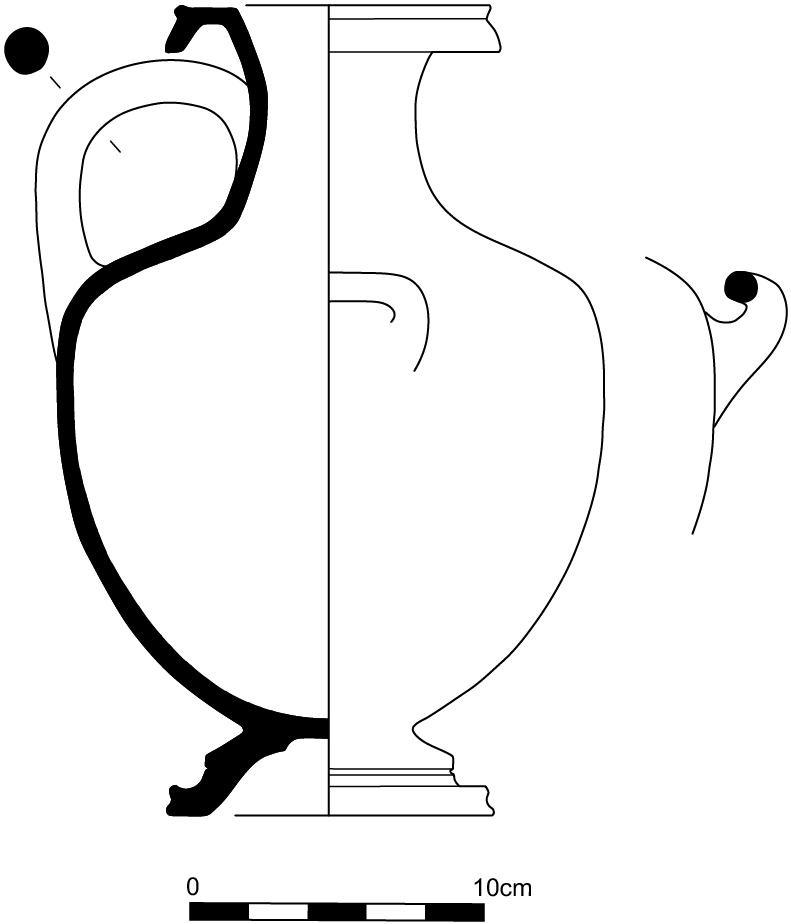
Subject
Apollo riding a griffin to the right. The god, beardless and long haired, wears a reserved wreath and a short cloak draped over his left shoulder. He rides astride and in profile, with his bare feet dangling, cradling a long laurel branch in his right arm. Most of his body is concealed by the wings of the griffin, which are executed in great detail, with clearly defined and overlapping covert and primary feathers. In the field above and below the griffin are two small circular objects of indeterminate character. The griffin’s face is lively and detailed, with tall pointed ears, a “beard” of fur or feathers, and a spikey crest. It lifts its front left paw to touch a woman, who springs to the right but looks back toward the griffin with her head in profile to the left. Her right leg drags behind her, with her foot frontal, as she bends deeply into her left leg, suggesting rapid movement. She wears earrings, a sakkos, and a peplos with a black border, the folds of which fall in an undulating zigzag pattern. She carries an oinochoe in her right hand and a lobed phiale in her left, suggesting that she is pouring a libation to Apollo. To the left of Apollo and facing right with his head in profile stands a male youth wearing a chlamys with a black border and shoes that lace halfway up his calves. His petasos hangs on his nape. He stands in a relaxed contrapposto pose with only the toes of the non-weight-bearing right foot touching the ground as his right leg bends. He languidly leans back, as if resting against the adjacent horizontal handle, and gestures with both hands toward Apollo.
Attribution and Date
Unattributed. Circa 380–360 BCE.
Dimensions and Condition
h. 27.9 cm; w. 23.2 cm; diam. 18.8; diam. of mouth 11.3 cm; diam of foot 10.8 cm. Body preserved intact. Small break in the foot repaired, and mouth and upper portion of the neck reattached. Black gloss streaky and mottled overall, likely resulting from both wear and misfiring. Some figural details worn, such as those around the waist and left arm of the youth, as well as the ovolo on the rim. Neck of the griffin speckled with black deposits.
Technical Features
Relief contours used sparingly. Curiously, the indistinct circle beneath Apollo’s feet is contoured with relief lines. Top of the rim, side of the lower foot, and underside of the foot coated with thin washes of reddish ocher.
Bibliography
Abbreviation: Princeton RecordRecord of the Princeton University Art Museum. (1942– ). 63 (2004): 135–36 [illus.].
Comparanda
The depiction of Apollo as a griffin rider is attested within the workshop of the Jena Painter, and Princeton’s hydria may be connected with his atelier, as K. Kathariou has suggested (private communication, December 8, 2003). This workshop, however, mostly produced drinking vessels and only one hydria: Berlin 3768 (Abbreviation: ARV2J. D. Beazley. Attic Red-Figure Vase-Painters. 2nd ed. Oxford, 1963 1516.81, 1697; Abbreviation: BAPDBeazley Archive Pottery Database. http://www.beazley.ox.ac.uk 231037). If one compares the Princeton hydria with a cup by the Jena Painter himself (Jena SAK 0465: Abbreviation: ARV2J. D. Beazley. Attic Red-Figure Vase-Painters. 2nd ed. Oxford, 1963 1512.14; Abbreviation: BAPDBeazley Archive Pottery Database. http://www.beazley.ox.ac.uk 230970), the details of the griffin and the general style differ noticeably. Cf. also a cup in Boston by an imitator of the Jena Painter: Boston 01.8092 (Abbreviation: ARV2J. D. Beazley. Attic Red-Figure Vase-Painters. 2nd ed. Oxford, 1963 1518; Abbreviation: BAPDBeazley Archive Pottery Database. http://www.beazley.ox.ac.uk 231056). Closer in the softness of the drawing and the expressive face of the griffin is a tondo on a cup by the Meleager Painter, who painted several hydriai: Malibu 82.AE.43 (Abbreviation: BAPDBeazley Archive Pottery Database. http://www.beazley.ox.ac.uk 28788). The griffin’s wings on the cup in Malibu, however, are drawn with less precision, while the facial details of the griffin and its rider differ markedly. Closer perhaps are the wings of Triptolemos’s chariot on a cup in the Vatican by the Jena Painter: Vatican 16551 (Abbreviation: ARV2J. D. Beazley. Attic Red-Figure Vase-Painters. 2nd ed. Oxford, 1963 1513.24, 1697; Abbreviation: BAPDBeazley Archive Pottery Database. http://www.beazley.ox.ac.uk 230980). (We are grateful to K. Kathariou for these references to the works from the Jena Painter’s workshop.)
Griffins in general are quite rare on hydria, and I. McPhee (private communication, May 6, 2003) compares the Princeton vase to another kalpis of the same date, without suggesting they are from the same hand: Osnabrück A 3627 (G. Franzius, “Antiken im Kulturgeschichtlichen Museum der Stadt Osnabrück, III” Abbreviation: BoreasBoreas: Münstersche Beiträge zur Archäologie 9 [1986]: 210, no. 6, pl. 32.3; Abbreviation: BAPDBeazley Archive Pottery Database. http://www.beazley.ox.ac.uk 30365). There a nude youth adopts a similar pose to that of the woman on the Princeton hydria, as though dramatically reeling before the god’s advent. For the bold, black-bordered drapery folds of the peplos worn by the woman on Princeton’s kalpis, cf. a similarly posed woman attending Amymone on another early Kerch-style kalpis, attributed by Schefold to the Herakles Painter and dated 370–60 BCE: St. Petersburg B 4125 (K. Schefold, Untersuchungen zu den kertscher Vasen [Berlin, 1934], no. 163, pl. 9.2; Abbreviation: BAPDBeazley Archive Pottery Database. http://www.beazley.ox.ac.uk 7018). No vase with a griffin, however, has been attributed to the Herakles Painter. On a hydria once in the London art market, the seated woman attended by a maid in this stance may be Helen: formerly London art market (Christie’s, Antiquities, auc. cat., November 7, 1990, London, lot 167; Abbreviation: BAPDBeazley Archive Pottery Database. http://www.beazley.ox.ac.uk 41528). If so, the young male at the left may be Paris, lounging near the side handle in much the same way as the youth on the hydria in Princeton.
The reeling stance of the woman became a stock posture assumed by figures on many vases starting shortly before 400 BCE, often in advance of a wheeling chariot conveying a god or hero; cf. the Amazon or Persian on Princeton 2007-98 (Entry 19). There are a number of other examples of women moving away from a griffin carrying Apollo or a beardless youth: e.g., attributed to Group G, Paris, Louvre MN 750 (Abbreviation: ARV2J. D. Beazley. Attic Red-Figure Vase-Painters. 2nd ed. Oxford, 1963 1465.75; A. Papanastasiou, Relations between Red-Figured and Black-Glazed Vases in Athens of the Fourth Century BCE [Oxford, 2004], pl. 14; Abbreviation: BAPDBeazley Archive Pottery Database. http://www.beazley.ox.ac.uk 230282). No divine epiphany is required, however, for the stance also becomes common among female attendants of women and brides, and is standard on lekanis lids of the Otchët Group: cf., inter alia, Gotha AK 253 (CVA Gotha, Schlossmuseum 2 [Germany 19], pls. 69, 71; Abbreviation: BAPDBeazley Archive Pottery Database. http://www.beazley.ox.ac.uk 8001).
For the Kerch style, so called after the modern name of ancient Pantikapaion, in the Crimea, see Abbreviation: ARV2J. D. Beazley. Attic Red-Figure Vase-Painters. 2nd ed. Oxford, 1963 1406–1509; Schefold, Kertscher Vasen (Berlin, 1930); id., Untersuchungen; I. I. Vdovichenko, “Kerch Vases,” Bosporos Studies 3 (2003): 380–539 [in Russian]; K. Lapatin, “Kerch-Style Vases: The Finale,” in Abbreviation: Colors of ClayB. Cohen, with contributions by Susan Lansing-Maish et al. The Colors of Clay: Special Techniques in Athenian Vases. Exh. cat. The J. Paul Getty Villa, Malibu, June–September 2006. Los Angeles, 2006, 318–41; O. Jaeggi, Attisch-rotfigurige Vasen des 4. Jhs v. Chr: Aus den Sammlungen des historisch-kulturellen Reservats in Kertsch (Kilchberg, 2012).
Griffins, alone or in company with Amazons or antagonistic Arimasps, are well attested in fourth-century Attic vase-painting. For the iconography of Apollo with a griffin, see H. Metzger, Les représentations dans la céramique attique du Ive siècle (Paris, 1951), 169–72; W. Lambrinudakis, in Abbreviation: LIMCLexicon Iconographicum Mythologiae Classicae. 1981–2009 2 (1984), 229–30, pl. 212, nos. 363–69, s.v. “Apollon”; V. Paul-Zinserling, Der Jena-Maler und sein Kreis: Zur Ikonologie einer attischen Schalenwerkstatt um 400 v. Chr. (Mainz, 1994), 80–84. The connection between Apollo and the hybrid beast perhaps arose out of the griffin’s association in the Near East with the sun, and its connection with Hyberborea, the region beyond the North Wind, where the native Arimasps were said to be in constant warfare with griffins, and where Apollo was thought to winter (see, inter alia, Plutarch, De E apud Delphos 398d). Griffins are most commonly depicted as part of a grypomachy, a subject that first becomes popular at the beginning of the fourth century. In art their opponents are commonly interpreted as Arimasps, though in appearance they can be difficult to distinguish from Amazons since both wear the same garb. The griffin rarely occurs as a companion of Apollo in the fifth century; in one of their earliest pairings, of about 420 BCE, on a bell-krater near the Dinos Painter, Apollo is astride the griffin and carrying a laurel branch, as on the Princeton hydria: Berlin F 2641 (Abbreviation: ARV2J. D. Beazley. Attic Red-Figure Vase-Painters. 2nd ed. Oxford, 1963 1155.8; Abbreviation: BAPDBeazley Archive Pottery Database. http://www.beazley.ox.ac.uk 215308).
Small hydriai such as this are quite popular in the fourth century, although not as numerous as kraters and pelikai. The ornament, with dotted ovolo above and below the figure scene as well as on the rim, is standard on hydriai of the second quarter of the century. A reasonably close parallel for the elaborate floral ornament occurs on an unattributed kalpis in the British Museum, which shows Apollo riding a swan, another common mount for the god in the fourth century: London E 232 (CVA London, British Museum 6 [Great Britain 8], pl. 96.3; Abbreviation: BAPDBeazley Archive Pottery Database. http://www.beazley.ox.ac.uk 5768). (We are grateful to K. Kathariou for this reference.)
